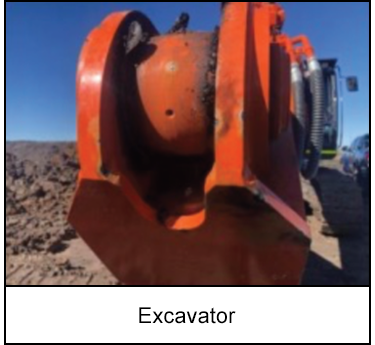-
What happened?
A construction crew was performing a trenchless pipeline crossing under a railway line adjacent to a 33Kv overhead powerline.
Due to recent rain events, an excavator was used to conduct rectification work on an access track to enable the construction crew to work on the opposite side of the railway line.
As the excavator was track rolling forward, the leading edge of the excavator boom encroached within the exclusion zone of the overhead powerline causing an electrical arc to occur between the powerline and the excavator boom.
The boom did not come into contact with the powerline and the powerline did not fall to the ground.
The excavator operator lowered the boom before moving the excavator to a safe location and remained in the cabin until it was safe to exit.

-
Why did it happen?
Documented processes were issued but not communicated and subsequently not followed.
Risk management processes were not followed.
The minimum approach distance to the overhead powerlines was not maintained.

-
What did they learn?
Consult with project personnel about reviewing and adherence to management system documentation and the requirements to undertake appropriate risk management processes.
Assess options for aerial high voltage protection systems (high voltage alarm / motion stop) for excavators.

-
Ask yourself or your crew
Do you operate mobile plant near live powerlines?
How do you identify the hazards prior to operating mobile plant near live powerlines?
What controls do you have in place?

Add to homescreen
Content name
Select existing category:
Content name
New collection
Edit collection
What happened?
A construction crew was performing a trenchless pipeline crossing under a railway line adjacent to a 33Kv overhead powerline.
Due to recent rain events, an excavator was used to conduct rectification work on an access track to enable the construction crew to work on the opposite side of the railway line.
As the excavator was track rolling forward, the leading edge of the excavator boom encroached within the exclusion zone of the overhead powerline causing an electrical arc to occur between the powerline and the excavator boom.
The boom did not come into contact with the powerline and the powerline did not fall to the ground.
The excavator operator lowered the boom before moving the excavator to a safe location and remained in the cabin until it was safe to exit.

Why did it happen?
Documented processes were issued but not communicated and subsequently not followed.
Risk management processes were not followed.
The minimum approach distance to the overhead powerlines was not maintained.
What did they learn?
Consult with project personnel about reviewing and adherence to management system documentation and the requirements to undertake appropriate risk management processes.
Assess options for aerial high voltage protection systems (high voltage alarm / motion stop) for excavators.
Ask yourself or your crew
Do you operate mobile plant near live powerlines?
How do you identify the hazards prior to operating mobile plant near live powerlines?
What controls do you have in place?
During trenchless pipeline construction near a high-voltage overhead powerline, an excavator encroached the exclusion zone, causing an electrical arc. The operator safely lowered the boom and moved the excavator to a secure location without contact or damage to the powerline.
Original material courtesy of Safer Together (Australia)
To access the PDF and PowerPoint versions, please visit https://www.safertogether.com.au/resources/sharing-library/mobile-plant-contact-with-live-electricity-learning-event-bulletin











